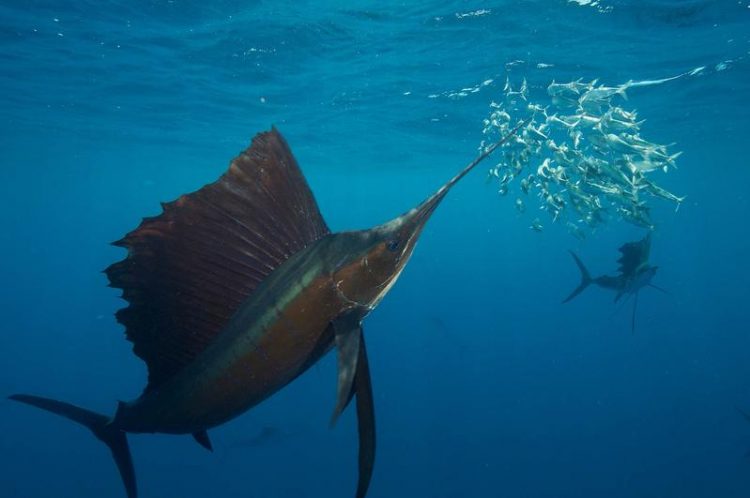Together we are unpredictable: why sailfish hunt more successfully as a group

A sailfish approaching its prey. Photo: Rodrigo Friscione
Predators and their prey evolve together: it is vital for predators to develop effective hunting strategies, whereas the prey species is intent on evading its attackers. An international team of researchers involving IGB has investigated the predator-prey relationship between sailfish (Istiophorus platypterus) and sardines (Sardinella aurita).
“When attacking, most sailfish specialise in attacks from either the left or the right, enabling them to attack more effectively,” reported Dr. Ralf Kurvers, lead author of the study whose results have now been published in the journal Current Biology.
The researcher and his team discovered that specialisation in attacking from the left or right – referred to technically as laterality – has its advantages in hunting. In fact, the more strongly an individual was lateralized, the more successful it was in capturing prey: the fish can attack very quickly with their preferred side.
This is an advantage because sardines are considerably more agile than their hunters. However, sailfish are only successful predators because they hunt in groups: a single sailfish that always attack from either the left or the right will have difficulty catching its prey, because the prey can then easily predict the side of attack.
The researchers were able to show that the key advantage of hunting in a group is that the prey species is unable to predict whether the sailfish are specialised in attacking from the left or from the right – making the predators more unpredictable to their prey. “The larger the group, the more balanced the left/right relationship is, and the more successful the sailfish will be in hunting sardines,” reported Dr. Kurvers.
In their study, the researchers analysed a total of 365 attacks by 73 sailfish, which occurred in 11 groups with up to 14 individuals per group, in the open ocean off the coast of Mexico. In a morphological analysis, the researchers also examined signs of wear in the microteeth on the long bill used by the predatory fish to attack their prey. This analysis confirmed that most fish prefer to attack from the left or from the right.
The fact that sailfish hunt in groups enables them – in evolutionary terms – to develop a very distinct specialisation. “Our study has enabled us to prove an important advantage that sailfish have when hunting in a group which, until now, was unknown,” explained Dr. Ralf Kurvers.
Incidentally, with around half of the sailfish preferring to attack from the right and the other half specialising in attacks from the left, laterality in sailfish differs from handedness in humans: some 90 per cent of the world’s population are right-handed, with only ten per cent preferring to use the left hand. “Using the same hand is useful when it comes to cooperative activities, which is why a predominant use of one hand has developed in the course of human evolution. The fact that left-handers still exist is explained by the advantages of this alternative laterality which, however, no longer plays an important role in today’s society – namely unpredictability in battle. Around half of top fencers, for example, are still left-handed, and the other half right-handed,” explained Dr. Kurvers.
Link to study: http://www.sciencedirect.com/science/article/pii/S0960982216315251
Kurvers RHJM, Krause S, Viblanc PE, Herbert-Read JE, Zaslansky P, Domenici P, Marras S, Steffensen JF, Wilson ADM, Couillaud P & Krause J (in press). The Evolution of Lateralization in Group Hunting Sailfish. Current Biology.
Contact person:
Dr. Ralf Kurvers
Leibniz-Institute of Freshwater Ecology and Inland Fisheries (IGB) and the Max Planck Institute for Human Development
ralf.kurvers@igb-berlin.de
+49 30 82406 472
About IGB:
www.igb-berlin.de
Work at IGB combines basic research with preventive research as a basis for the sustainable management of freshwaters. In the process, IGB explores the structure and function of aquatic ecosystems under near-natural conditions and under the effect of multiple stressors. Its key research activities include the long-term development of lakes, rivers and wetlands under rapidly changing global, regional and local environmental conditions, the development of coupled ecological and socio-economic models, the renaturation of ecosystems, and the biodiversity of aquatic habitats. Work is conducted in close cooperation with universities and research institutions from the Berlin/Brandenburg region as well as worldwide. IGB is a member of the Forschungsverbund Berlin e.V, an association of eight research institutes of natural sciences, life sciences and environmental sciences in Berlin. The institutes are members of the Leibniz Association.
http://www.igb-berlin.de/ IGB-Website
http://www.sciencedirect.com/science/article/pii/S0960982216315251 Paper on sailfish in Current Biology
Media Contact
All latest news from the category: Life Sciences and Chemistry
Articles and reports from the Life Sciences and chemistry area deal with applied and basic research into modern biology, chemistry and human medicine.
Valuable information can be found on a range of life sciences fields including bacteriology, biochemistry, bionics, bioinformatics, biophysics, biotechnology, genetics, geobotany, human biology, marine biology, microbiology, molecular biology, cellular biology, zoology, bioinorganic chemistry, microchemistry and environmental chemistry.
Newest articles

First-of-its-kind study uses remote sensing to monitor plastic debris in rivers and lakes
Remote sensing creates a cost-effective solution to monitoring plastic pollution. A first-of-its-kind study from researchers at the University of Minnesota Twin Cities shows how remote sensing can help monitor and…

Laser-based artificial neuron mimics nerve cell functions at lightning speed
With a processing speed a billion times faster than nature, chip-based laser neuron could help advance AI tasks such as pattern recognition and sequence prediction. Researchers have developed a laser-based…

Optimising the processing of plastic waste
Just one look in the yellow bin reveals a colourful jumble of different types of plastic. However, the purer and more uniform plastic waste is, the easier it is to…



